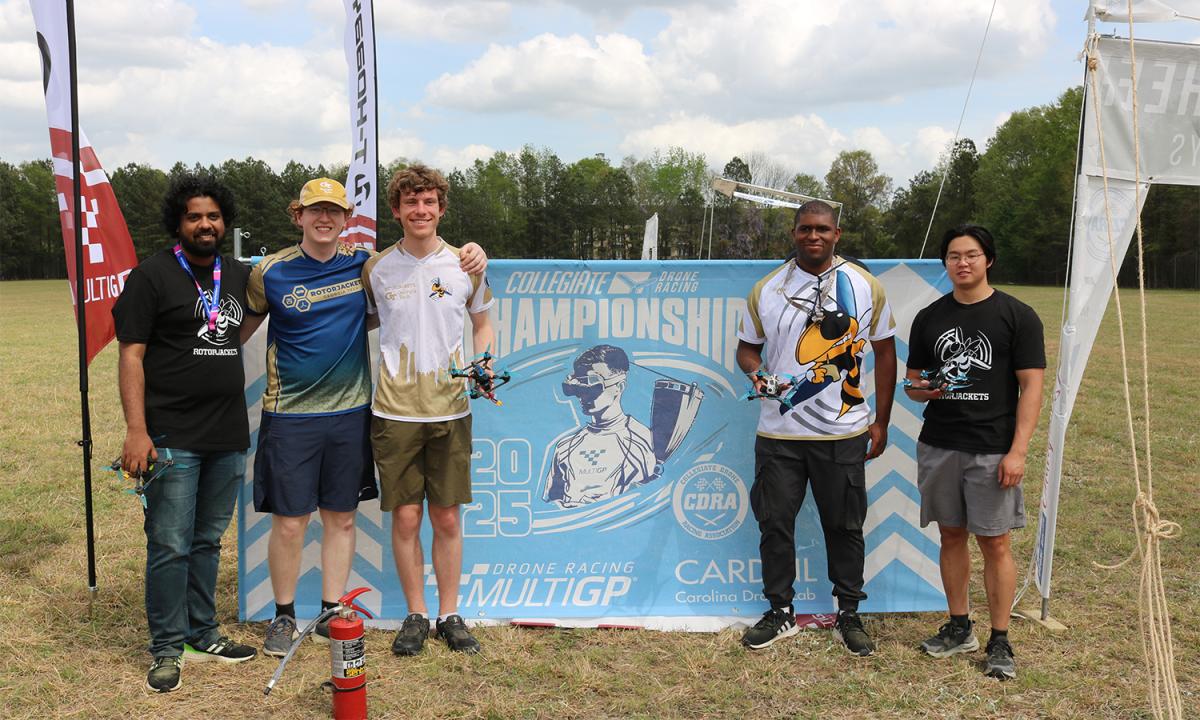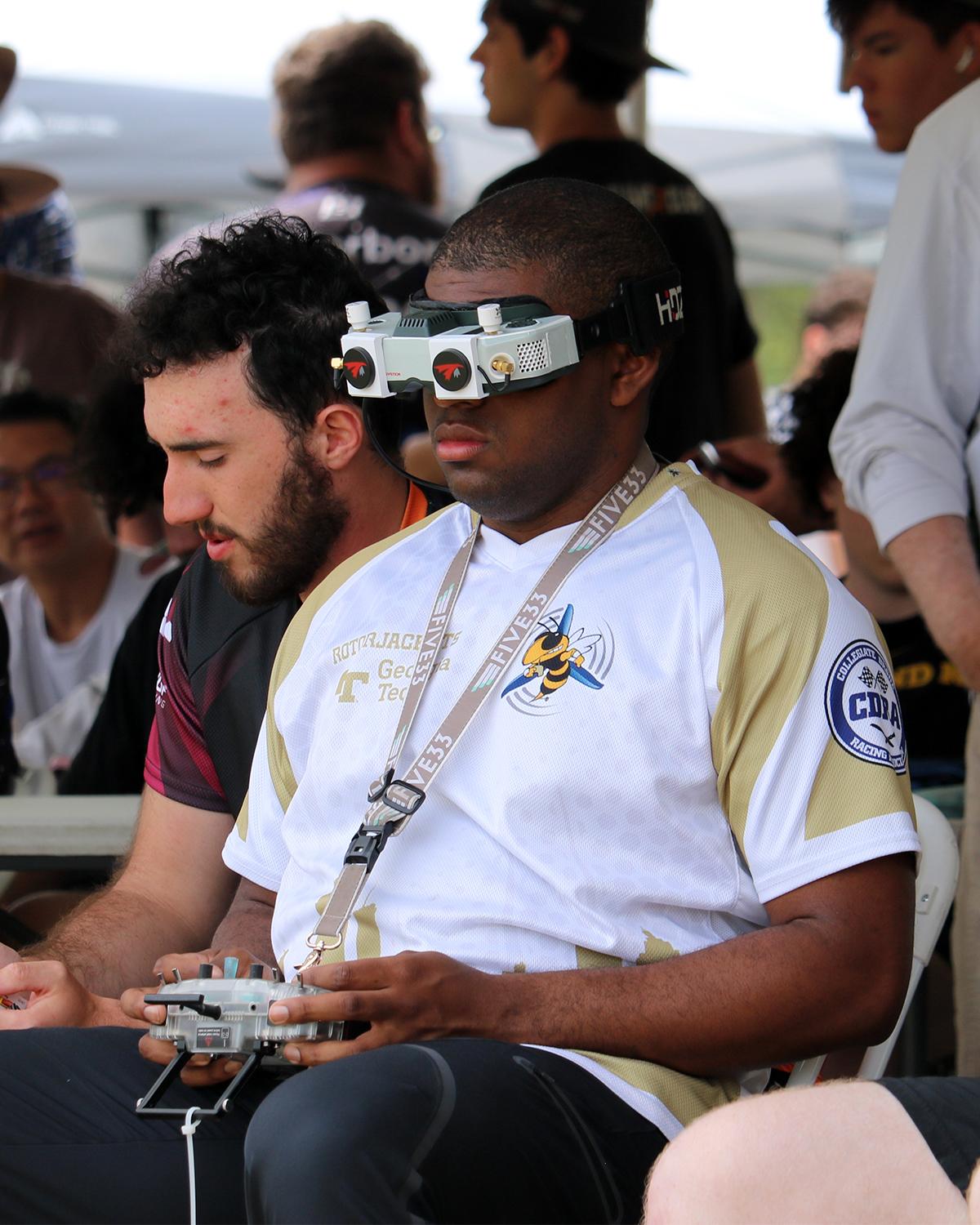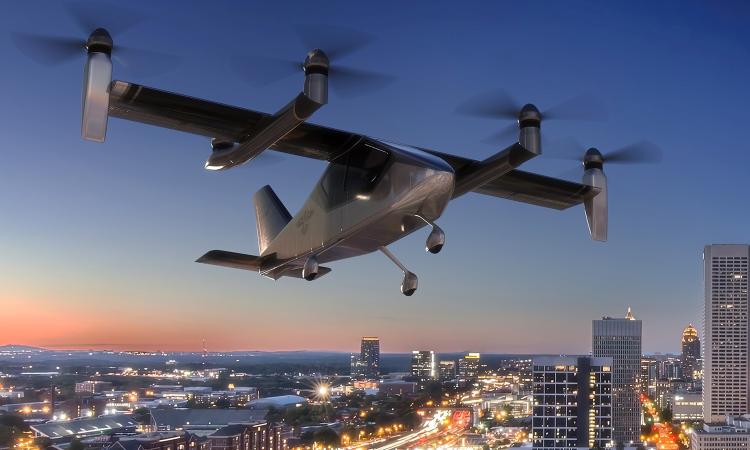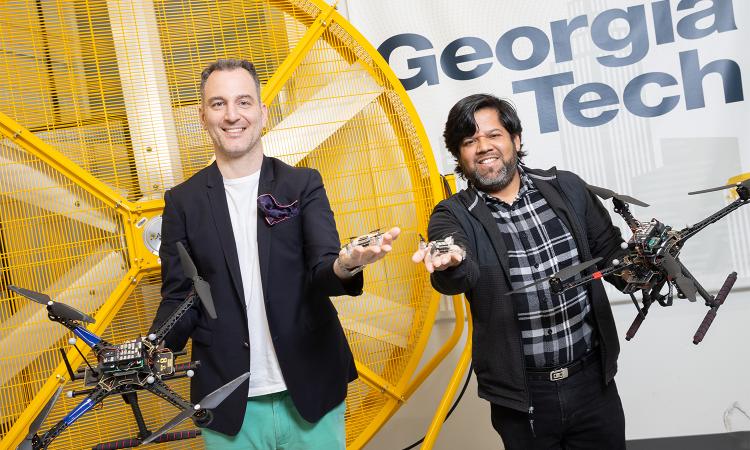Meet the campus club that’s become a powerhouse in collegiate drone racing, built a community of drone enthusiasts, and inspires the next generation of pilots and engineers.
(text and background only visible when logged in)

The RotorJackets team at this year’s Collegiate Drone Racing Championship. From left: Adarsh Kumar, Ian Boraks, Caden Perry, Dylan Wyckoff, and Aison Tran. (Photo: James Trimble)
(text and background only visible when logged in)
The drones weigh barely a pound and roar through obstacle-laced courses at nearly 100 miles per hour. They zigzag through gates, tunnels, and hairpin turns in a race that’s over in less than 90 seconds. One slip and it’s game over.
It’s a jolt of pure adrenaline for the pilots, who control a blur of speed with instinct and precision. This is collegiate drone racing, and Georgia Tech’s RotorJackets are among the best.
Founded less than a decade ago, the student team has become a national powerhouse. The squad has finished in the top four at the Collegiate Drone Racing Championship (CDRC) for the past four years — including back-to-back national titles in 2022 and 2023.
Each drone is custom built by students. Pilots wear goggles outfitted with a live video feed from the drone’s perspective. The key is avoiding mid-air collisions.
“Racing is like learning how to run,” said second-year aerospace engineering student Caden Perry. “You don’t think about each muscle; you just move instinctively. That’s what it’s like when you’re locked in during a race.”
Perry came to Tech already fascinated with that first-person-view (FPV) technology. He had experimented with custom drone designs in high school and joined RotorJackets to push his skills further.
“The experience is so immersive that sometimes I forget for a moment I’m on the ground. I’ll lean the way I want the drone to go or jerk my head a little to avoid a gate,” Perry said.
Like Perry, RotorJackets president Dylan Wyckoff also had experience with casual flying and joined the club to learn about building his own drones. He quickly realized the steep learning curve when he put on the racing goggles.
“The difference between casual flying and racing is like learning to ride a bike versus competing in BMX,” said Wyckoff, a fifth-year computer science student. “The first drone I built was five inches. And for a good two months, I couldn’t even fly it just because of how hard it was. I spent those two months in a simulator trying to get used to it before I had the ability to actually fly through a racecourse.”
It was time well spent. After placing 40th at his first race, Wyckoff climbed to 19th the following year.
Research, Outreach, and Cinematography
RotorJackets’ impact extends beyond the racecourse. The team regularly collaborates with Georgia Tech research labs, providing expertise to students and faculty working on drone-related studies. The group also hosts outreach events, visiting Atlanta-area K-12 schools to introduce younger students to drone technology.

Ian Boraks (left) and Caden Perry make adjustments to the drones during competition. (Photo: Dylan Wyckoff)
The group has developed lesson plans to teach high school students about how the machines work and their uses, including some basic CAD modeling and design.
“There’s a misconception sometimes that drones are just for military use or surveillance,” Perry said. “We want to show people the positive applications — whether it’s in filmmaking, environmental monitoring, or engineering.”
The RotorJackets have become a go-to source for aerial cinematography on campus. From capturing homecoming celebrations such as the Mini 500 to filming vehicle tests for the GT Off-Road student competition team, RotorJackets members have built a reputation for stunning footage. They’ve also worked with Georgia Tech Athletics and other units on campus on specific projects. And sometimes they’re just in the air because it’s a can’t-miss opportunity.

Dylan Wyckoff pilots a drone at the Championship. (Photo: James Trimble)
“We’ve flown around the football stadium and Tech Tower. We worked with the CRC [Campus Recreation Center] to film the pools, the gym area, and on every floor,” Wyckoff said. “And during the snow days [in January], we did some filming all around campus to get those winter shots.”
Keeping the Club in the Air
Community is a big part of what keeps RotorJackets flying. Thanks to industry sponsors and funding from the Student Government Association, the club has the tools and parts to help new pilots take off. The speed and competitiveness of drone races can make novices wary of putting their treasured drones on a course only to damage or, worse, crash them. The team keeps extra parts, tools, and batteries on hand so members can fix issues, test builds, and keep flying.
RotorJackets has strong relationships with the Daniel Guggenheim School of Aerospace Engineering, the Georgia Tech Police Department, and the Federal Aviation Administration (FAA). The club spearheaded efforts to secure an FAA-Recognized Identification Area over Stamps Field. That allows drones to be flown without remote identification equipment so the team can practice for competitions and hold events for the campus community to get hands-on flying experience.
The group also has a robust Discord server with more than 550 members — students, professional pilots, and drone enthusiasts from across the country who engage in regular discussions, share technical advice, and plan meetups. That community has meant continuity as student leaders graduate and move on, helping establish RotorJackets as a national force.
“We’re Georgia Tech,” Perry said. “When students get involved and find their passion, they’re going to put in the time to make themselves great.”
(text and background only visible when logged in)
(text and background only visible when logged in)
Related Stories

Engineering 21st Century Flight
The new ideas and emerging designs that will carry us into the future thanks to the work of Georgia Tech engineers.

Winning the Zero-Sum Game
In the quest to ensure drones and other autonomous vehicles operate safely, engineers have to out-think the malicious attackers who might try to take over.

These Engineers are Flying High
Meet alumni working at some of the world’s leading aerospace organizations to innovate, fly safer, and travel farther.
(text and background only visible when logged in)

Helluva Engineer
This story originally appeared in the Spring 2025 issue of Helluva Engineer magazine.
Not where we are, but where we’re going — whether it’s here on the ground or millions of miles away. Georgia Tech engineers are shaping the rapidly shifting future of how we’ll fly people and stuff. Our engineers are helping get humans to the moon and, eventually, Mars, while creating the tools to help us unravel some of our solar system’s deepest mysteries. The sky is no limit in the Georgia Tech College of Engineering. Take off with us into The Aerospace Issue.